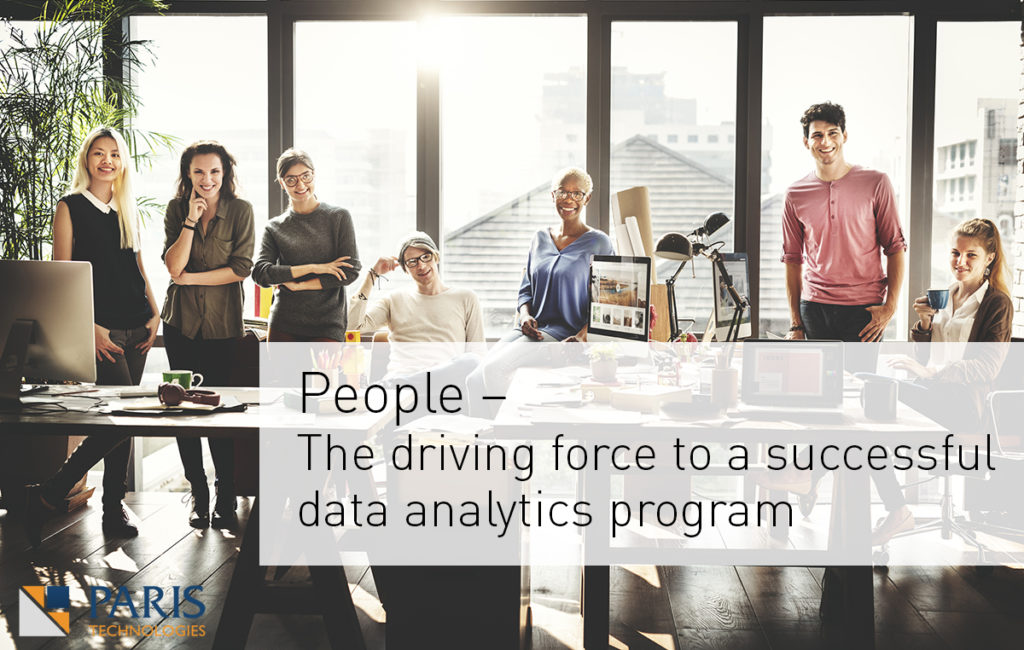
In most data analytics projects, much focus is put on the tools that need to be implemented. Understandably so, since choosing the right tools for your organization’s BI stack is crucial in defining the data analytics process. Not to mention, the cost of such tools needs to be considered.
However, tools are just half of the equation.
Having the right people involved in a data analytics project is just as crucial. In fact, it is the driving factor behind any successful data analytics initiative.
Who are these people?
The people involved in a data analytics project are individuals with different capabilities across departments and hierarchies of your organization, as well as individuals from outside your organization.
These people contribute their own knowledge and skills in various parts of the project.
In this blog, we identify the key stages of a data analytics implementation and the roles that people play to drive the project to success.
Well-defined objectives and priorities sets the stage for success.
In a study by KPMG, they found that only one-third of CEOs trust the accuracy of their Data Analytics. This is important to know because a bad experience with BI could turn a project from top priority to a trivial matter, which some executives even resist. Consequently, strong support from a stakeholder or C-suite could be the determining factor for the success of a data analytics project.
If you are this person, a CEO or CFO, how you regard your data analytics project sets the tone for your entire organization. To kick-off a successful data analytics project, you will need to clearly define the purpose and goals of the project, and set priorities.
This will guide your people in the right direction to move forward. By setting achievable and realistic milestones, your organization can keep their focus on the purpose and goals of the project, as data analytics tend to be a big and intimidating topic to tackle.
“The impact of “big data” analytics is often manifested by thousands—or more—of incrementally small improvements. If an organization can atomize a single process into its smallest parts and implement advances where possible, the payoffs can be profound. And if an organization can systematically combine small improvements across bigger, multiple processes, the payoff can be exponential.”
– Making data analytics work for you—instead of the other way around, By Helen Mayhew, Tamim Saleh, and Simon Williams, Article from McKinsey Quarterly, October 2016.
Thinking about which use cases add the most value to your business helps in identifying the purpose of your data analytics project. Do you want to increase profitability? Are you looking to improve operational performance? Do you want to accelerate product development process? Questions such as these will point you to a specific problem that you want to solve.
In turn, the problem you have identified will define the scope of the data analytics project. It will identify which data sets are relevant to the problem, making it more manageable for your people. As a C-suite or stakeholder who is leading this project, you need to understand that data preparation takes time and is necessary for data quality. Therefore, you do not want your team to spend their valuable time cleaning and preparing data that has little, if any, significance to the purpose of the project.
A clearly defined scope will also effectively provide quicker results. Hence, you will have an idea if you are digging on the right spot and just need to power through to get to that pot of gold, or if you need to re-orient your goals to a different direction.
Explore your data sources – historical and unconventional
Traditionally, the next step would be for a technical team to start trudging the historical data landscape of the organization. This includes legacy systems, databases, excel spreadsheets, or anything that resembles structured data. Indeed, this is still a vital part of the data analytics process. The value of insights that can be gathered from historical data cannot be discounted. However, in today’s world of big data, unstructured information from unconventional sources provide insights that could be the competitive advantage that you are looking for. For example, you may have already heavily invested on R&D of a new product and have a very sophisticated approval process. However, the knowledge of timing the launch of the product could be gathered from social media activity and commentaries. Those so called soft information will connect the dots to success.
Having your IT team support your data analytics projects is a given. You need engineers who can setup the infrastructure and systems you have chosen, and data scientists to develop data models and complex algorithms. (Or, you can outsource data model and algorithm tasks to experts, like PARIS Tech, if hiring a data scientist is out of scope for your budget.)
However, depending on the goals you have defined, other departments could provide essential knowledge relevant to the project. This is where people of different expertise come in. For example, HR could be useful if you are looking to improve employee performance. Finance could be tapped if you are looking to cut costs. Marketing could provide intel from social media if you want to improve customer experience.
Generate actionable insights from consumable information
The result of a data analytics project should be meaningful information that provides business knowledge. To get to this, another vital step in the data analytics process is the presentation of data.
Often mistaken as a synonym for Business Intelligence, data visualization tools have gained popularity because they give users the capability to create beautiful dashboards. However, organizations should be careful of such tools, as their self-service nature lacks quality control and often bypasses data warehouses and BI tool stack.
That said, beautiful dashboards are not just for show. Information is easier to consume when it’s presented in nice, sparkly dashboards. Visual elements attract our eyes, hold our attention, and help us understand quicker as compared to columns and rows of data.
Because of this, organizations are now engaging graphic artists and designers to better articulate information into easily digestible visual elements.
On the other hand, generating actionable insights requires the involvement of team managers, as changes brought about by data analytics are usually on a granular level. These small changes become significant with the cooperation of the entire organization.
Partner with experts to extend capabilities
Managing a data analytics project exclusively within the organization can be challenging as it requires building new skill sets or hiring new people that already possess those skills. This can distract from your focus on the project and delay the results. Therefore, working with a partner with expertise in data analytics can provide a high return on investment.
There are several benefits of working with a partner on a data analytics project. It eliminates the need to hire and maintain in-house teams and typically accelerates the data analytics process because of the knowledge and experience they already possess. Partners are a valuable resource that you can tap for expert advice especially on tricky implementation processes that require both technical and industry knowledge.
Fostering collaboration to fulfill the purpose
Organizations need to be able to identify people within their team who understand and appreciate data analytics and the benefits that can be gained. It is up to the C-suite and stakeholders to foster collaboration among these individuals to create a culture of data within the organization. At the same time, having a flexible data analytics solution that individuals can utilize makes the project more relevant to their role and will help increase internal engagement.
Summary
Think of your data analytics project as building a house. There are a lot of people involved. The owner of the house needs to define the purpose of the house. Is it a family house or a bachelor pad? Do you want a big play area for the kids or a nice kitchen and living area to entertain guests? These initial decisions will ultimately guide the entire building plan and the people involved in building the house. The same is true for a data analytics project. The initial decisions that the C-suite and stakeholders make are crucial factors that will drive the entire project. Then there are the people who will live in the house. Think of them as the end-users of your data-analytics project. Make the information available to them as they would utilize the rooms of house according to their needs. Then you have your architects, contractors, carpenters, plumbers, landscapers, designers, and several specialists, and maybe you have a foreman running the show. Less obvious, but still involved, are town regulators who make sure you follow the rules within your town or district. These people are working together to build the house you defined. In a data analytics project, you have people with different expertise from your internal team and outside partners all working and collaborating towards a goal and a purpose.
Success is relative, but we can say that a data analytics project is successful if the entire organization, not just the C-suite and stakeholders, are able to understand the business with better clarity.

